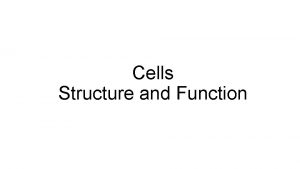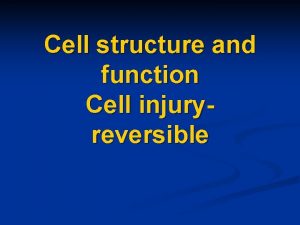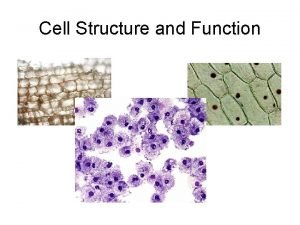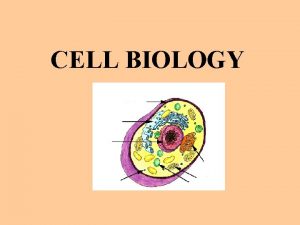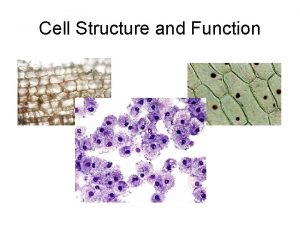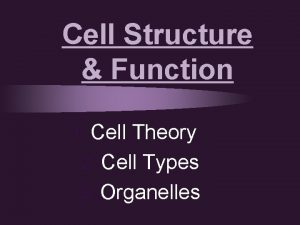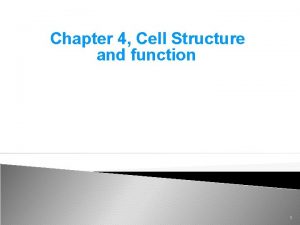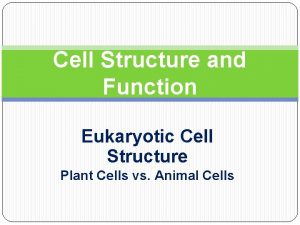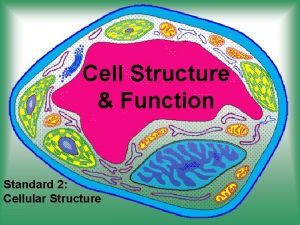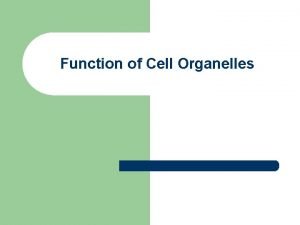THE CELL CELL STRUCTURE FUNCTION Review cell structure




















- Slides: 20

THE CELL

CELL STRUCTURE + FUNCTION • Review cell structure + function (text 4. 1)

THE NUCLEUS

The Nucleus • The control centre of a living cell • Surrounded by nuclear membrane (kind of like cell membrane). Ø Function: Protects contents of nucleus • Inside is membrane-free nucleolus Ø Function: make ribosomes (whose job it is to make proteins) • Has small openings in nuclear membrane called nuclear pores Ø Function: Allow certain things in/out of nucleus (ex. ribosomes).

DNA

DNA The nucleus contains the master set of instructions that determines what each cell will become, how it will function, when it will grow and divide, and when it will die The instructions in the nucleus are carried in long, two-stranded molecules called deoxyribonucleic acid, or DNA.

DNA • The DNA molecule looks like a twisted ladder • The two strands, or sides, of the DNA ladder wrap around each other in a spiral shape that scientists call a double helix. • The word “helix” comes from a Greek word meaning to wrap. • • A (adenine), G (guanine), C (cytosine), and T (thymine) • The sides of the DNA ladder are made of sugar and phosphate (often called the sugar-phosphate “backbone”. • The steps of the ladder are made of four nitrogen bases, which are represented by the letters:




DNA ARRANGEMENT • Everything that occurs within a cell is the result of how the bases on the DNA molecule arranged. This arrangement is known as the DNA message. • Bases in a DNA molecule always join in a specific way: • A always joins with T • G always joins with C • However, the order and number of these bases can vary greatly within the DNA molecule. In humans, a single DNA molecule can be several million base pairs in length.

How is DNA stored? • DNA exists in the nucleus in the form of chromatin. • Chromatin is a substance that contains DNA and proteins • Within each strand of chromatin is one molecule of DNA

When a eukaryotic cells is ready to divide, each strand of chromatin coils up into a very compact, X-shaped structure called a chromosome

Chromosomes • Chromosomes within the nucleus are found in pairs. • Most human cells have 46 chromosomes arranged in 23 pairs, including one pair of chromosomes that help determine sex. • In biological males, the 23 rd pair of chromosomes is the XY pair. • In biological females, it is the XX pair. • Every living thing has a characteristic number of chromosomes

GENES ARE FOUND ON CHROMOSOMES • Genes are small segments of DNA located at specific places on a chromosome • Genes store the information needed to produce 90 000 to 100 000 different proteins used in the cells of your body. • The arrangement of bases in a gene will usually be used to produce a specific protein. • Genes can vary in length from hundreds to thousands of bases. • Every chromosome carries thousands of genes and therefore contains the information to make thousands of different proteins.



PROTEIN SYNTHESIS You aren’t expected to know this by heart in Gr. 9 – but being familiar with the process will be helpful for next year

Protein Synthesis Making protein Exporting protein

4 -1 D p. 133 Strawberry DNA LAB Create a Pre-Lab for next class. Include: • Research question • Hypothesis • Methods (reference the materials + procedure) • Data Table Skeleton(s) You’ll be collecting data and then writing a conclusion and answering analysis questions
 Chapter 7 cell structure and function section review 7-2
Chapter 7 cell structure and function section review 7-2 What is the function of a cell
What is the function of a cell Hát kết hợp bộ gõ cơ thể
Hát kết hợp bộ gõ cơ thể Ng-html
Ng-html Bổ thể
Bổ thể Tỉ lệ cơ thể trẻ em
Tỉ lệ cơ thể trẻ em Voi kéo gỗ như thế nào
Voi kéo gỗ như thế nào Chụp phim tư thế worms-breton
Chụp phim tư thế worms-breton Alleluia hat len nguoi oi
Alleluia hat len nguoi oi Kể tên các môn thể thao
Kể tên các môn thể thao Thế nào là hệ số cao nhất
Thế nào là hệ số cao nhất Các châu lục và đại dương trên thế giới
Các châu lục và đại dương trên thế giới Cong thức tính động năng
Cong thức tính động năng Trời xanh đây là của chúng ta thể thơ
Trời xanh đây là của chúng ta thể thơ Mật thư tọa độ 5x5
Mật thư tọa độ 5x5 Làm thế nào để 102-1=99
Làm thế nào để 102-1=99 độ dài liên kết
độ dài liên kết Các châu lục và đại dương trên thế giới
Các châu lục và đại dương trên thế giới Thơ thất ngôn tứ tuyệt đường luật
Thơ thất ngôn tứ tuyệt đường luật Quá trình desamine hóa có thể tạo ra
Quá trình desamine hóa có thể tạo ra Một số thể thơ truyền thống
Một số thể thơ truyền thống
























